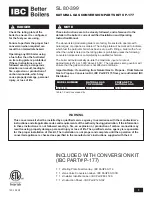
Finned copper tube gas boilers & water heaters – Boiler Manual
29
11. Turn the knob on the pilot valve to on, Figure 18.
12. Turn the knob on the main gas valve to on, 300 and 400 models,
Figure 18. On 600 through 2100 models open the manual shutoff
valve located in the control compartment, Figure 19.
13. Turn on all electric power to the boiler.
Figure 19
Manual Valve & Manifold Pressure Tap
14. Set the staging control or thermostat to the desired setting.
15. The pilot should automatically light. Do not try to light the pilot
by hand!
16. The burners should light with proper boiler operation.
17. The pilot and manifold pressures should match those listed
in Table 19. To adjust the manifold gas pressure see the “Gas
Pressure Adjustment” instructions in the “CHECKING AND
ADJUSTMENTS” section.
Required Gas Pressure
Provide gas supply pressure at inlet to boiler gas train as follows:
LP
Nat
Minimum (in WC)
11
7
Maximum (in WC)
14
14
Measure pressure when the boiler is firing at full rate. Low gas pressure
could indicate undersized gas line or insufficient gas supply.
"Static and operating gas pressure required at the gas valve inlet is
between 7 in WC and 14 in WC for natural gas and 11 in WC and
14 in WC for propane. If the gas pressure is above this limit, a lock-up
style regulator suitable for dead end service such as an Equimeter
or Fisher must be installed to prevent increase (creep) of gas pressure
when the units are not operating. This pressure regulator (supplied
by others) may be installed at the service entrance to each unit or
a "master" regulator sized to handle multiple units may be utilized.
Consult local gas utility or regulator manufacturer for recommenda-
tions to meet specific job site requirements."
Table 19 (D300-D2100) Pilot & Manifold Settings – (D300 On/Off Only)
Natural Gas
inches W.C.
mm W.C.
Low Fire
1.5 ± .02
33 ± 5
High Fire
2.5 ± 0.2
63 ± 5
LP Gas
inches W.C.
mm W.C.
Low Fire
3.9 +/- 0.2
99 ± 5
High Fire
9.3 +/- 0.2
236 ± 5
Table 20 (D300-D2100) Combustion Readings – (D300 On/Off Only)
Natural Fuel
Propane Fuel
CO
2
%
7.0 - 7.5 (low)
8.2 - 8.9 (low)
7.8 - 8.5 (high)
9.2 - 9.9 (high)
O
2
%
8.3 - 7.6 (low)
8.3 - 7.6 (low)
7.0 - 5.8 (high)
7.0 - 5.8 (high)
Instructions De Mise En Marche
1. ARRÊTEZ! Lisez les instructions de sécurité sur la portion
supérieure de cette étiquette.
2. Réglez le thermostat à la température la plus basse.
3. Coupez l'alimentation électrique de l'appareil.
4. Cet appareil est muni d'un dispositif d'allumage qui allume
automatiquement la veilleuse. Ne tentez pas d'allumer la veilleuse
manuellement.
5. Fermer la vanne manuelle d'arrêt d'alimintation de gaz.
6. Attendre cinq (5) minutes pour laisser échapper tout le gaz.
Reniflez tout autour de l'appareil, y compris près du plancher,
pour déceler une odeur de gaz. Si vous sentez une odeur de gaz,
ARRÊTEZ! Passez à l'étape B des instructions de sécurité sur la
portion supérieure de cette étiquette. S'il n'y a pas d'odeur de gaz,
passez à l'étape suivante.
7. Ouver la vanne manuelle d'arrêt d'alimintation de gaz.
8. Mettez l'appareil sous tension.
9. Réglez le thermostat à la température désirée.
10. Si l'appareil ne se met pas en marche, suivez les instructions
intitulées couper l'admission de gaz de l'appareil et appelez un
technicien qualifié ou le fournisseur de gaz.
To Turn Off Gas To Appliance
1. Set the operating control or thermostat to its lowest setting.
2. Turn off all electric power to the appliance if service is to be
performed.
3. Close the manual main valves.
COUPER L'ADMISSION DE GAZ DE L'APAREIL
1. Réglez le thermostat à la température la plus basse.
2. Coupez l'alimentation électrique de l'appareil s'il faut procéder
à l'entretien.
3. Fermer la vanne manuelle d'arrêt d'alimintation de gaz.
















































